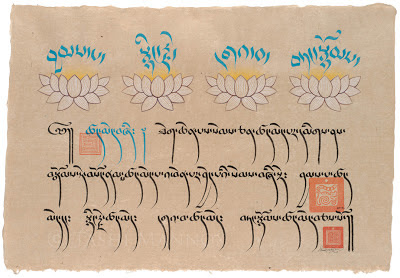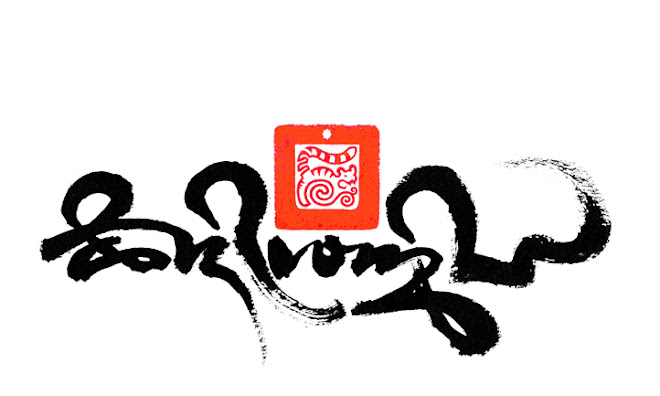Once again the Russian Federation hosts the worlds foremost exhibition of contemporary calligraphy in Moscow. This 2012 biannual event runs between 1st November until the 15th December. A diverse and colourful exhibition that represents over 40 world class calligraphy artists of different language traditions, who have contributed calligraphic masterpieces to celebrate the beauty of handwriting, excelling their artistic abilities in the name of keeping such calligraphy traditions alive.
The exhibition officially opened on the 1st November with a grand event that attracted much media attention as captured here.
The exhibition officially opened on the 1st November with a grand event that attracted much media attention as captured here.
A beautifully styled catalog of the exhibition artworks and their creators has been skillfully made available 'electronically' :
There is also a 'virtual excursion' that allows remote live viewing of the exhibition via CCTV cameras placed strategically around the gallery halls.
Since the Contemporary Calligraphy Museum of Moscow first held their international calligraphy exhibition in 2008, Tashi Mannox has been invited to exhibit with three of their biennials. This year Tashi especially created two art pieces and donated a third for the 2012 show.
One such piece especially created, as shown in the above snap-shot of the catalog, called "Homage to the Three Jewels" can also be seen with a more detailed explanation in a previous blog post here.
The other calligraphy art piece exclusively created for Moscow is called "The Four Immeasurable States" (as below) another calligraphy based on a classical Buddhist theme and popular for a strongly growing Buddhist community in Russia.
༄། ཚད་མེད་བཞི། །
 |
|
"The Four Immeasurable States"
Chinese ink and Japanese mineral paint on
Bhutanese tsasho paper,
57x84cm ⓒ Tashi
Mannox 2012.
|
Seated on the four open lotus flowers are the four immeasurable states:
བྱམས་པ་ སྙིང་རྗེ་ དགའ་བ་ བཏང་སྙོམས་
Love, Compassion, Joy,
Equanimity.
These four key words are highlighted in blue calligraphy of the Drutsa script
style. Below which is a round
tailed Drutsa script from the 14th century Tibet. This particular rare round tailed Drutsa was gathered together after months of research pouring over ancient Tibetan manuscripts, in Uchen this reads as:
༄།ཐེག་ཆེན་པས་སེམས་ཅན་ཚད་མེད་པར་དམིགས་ནས་བསྒོམས་ཏེ་བསོད་ནམས་ཚད་མེད་པ་འཕེན་པར་བྱེད་པའི་སེམས་བཞི་སྟེ།བསོད་ནམས་ཚད་མེད་པ་འཕེན་པར་བྱེད་པའི་སེམས་བཞི་སྟེ། བྱམས་པ་ཚད་མེད་དང། སྙིང་རྗེ་ཚད་མེད། དགའ་བ་ཚད་མེད།
བཏང་སྙོམས་ཚད་མེད་བཅས་སོ།
“According to the Mahayana by meditation that focuses on measureless
beings there are four states of mind that set in motion measureless punya
(auspicious or positive effects or states), namely:
Measureless love, measureless compassion, measureless joy and measureless
equanimity”
Translation by Lama Shepen Hookham at the
request of Tashi Mannox June 2011.
The below photos taken at the 4th International Exhibition of calligraphy showing four of Tashi's artworks displayed among other calligraphy traditions, such as Islamic and classical Chinese.
 |
| "The Four Immeasurable States" |
 |
| The exhibits |
 |
| contemplation |
 |
| "Seven line prayer to Guru Rinpoche" |
 |
| "Seven line prayer to Guru Rinpoche" detail |
 |
| "Homage to the Three Jewels" |
 |
| "Sacred Mantra" and "Homage to the Three Jewels" |
 |
| "Sacred Mantra" close up observation |
 |
| "Sacred Mantra" detail |
 |
| "Sacred Mantra" |
Up close.... Visitors during the official opening of the IV International Exhibition of Calligraphy 2012, take in detail of one of Tashi's earlier art pieces called "Sacred Mantra" donated to the Moscow Contemporary Calligraphy Museum in 2010.

















